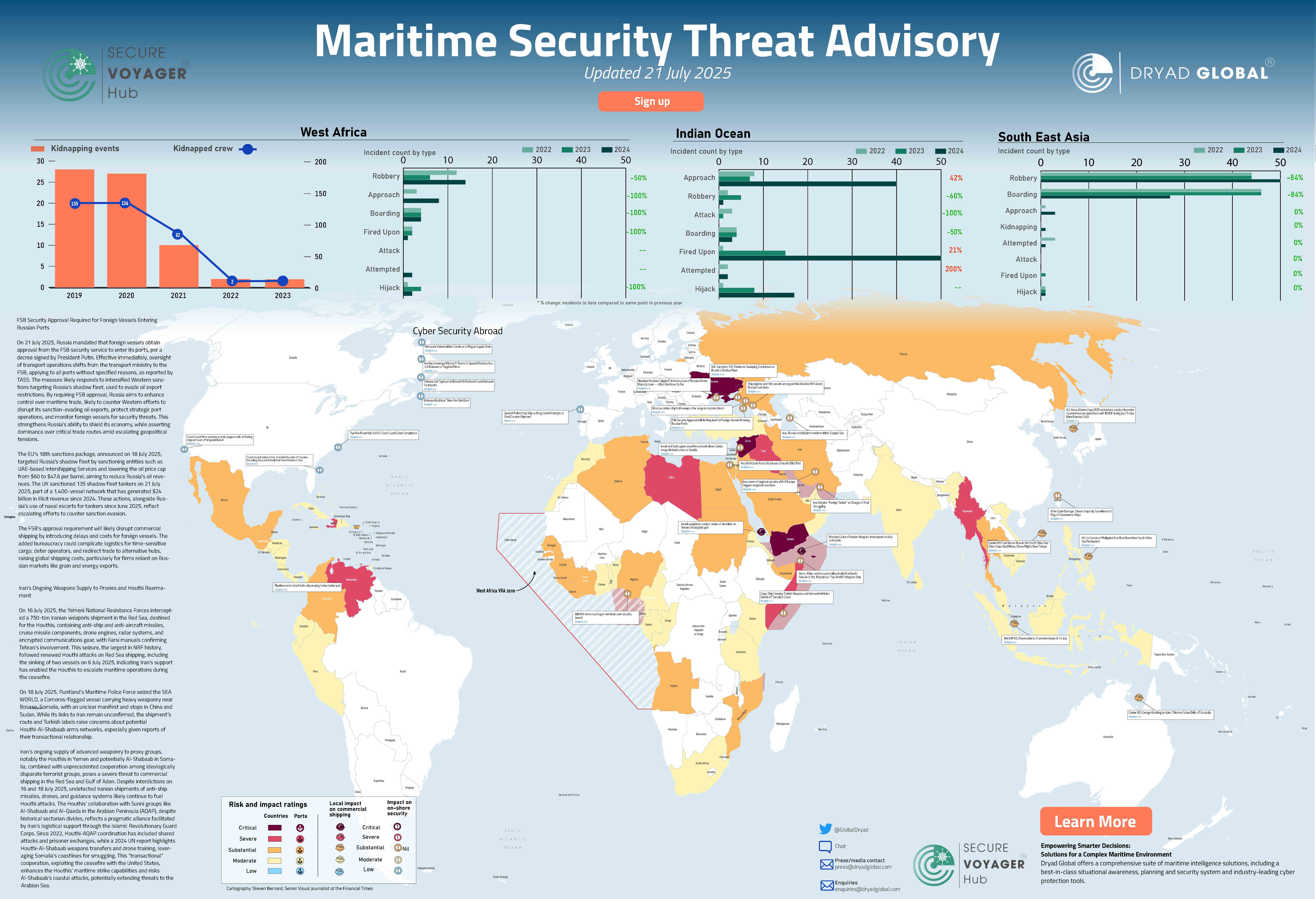As geopolitical tensions and regional instabilities continue to shape the global maritime landscape, Dryad Global’s latest Maritime Intelligence Brief offers a comprehensive snapshot of threat levels, key developments, and regional incident trends across critical shipping routes.
This week’s update underscores a complex and evolving threat picture, especially in regions like the Red Sea, West Africa, and the Indian Ocean. Here’s a breakdown of the key insights and developments as of 22 July 2025:
FSB Security Approval Required for Foreign Vessels Entering Russian Ports
-
This is likely a response to intensified Western sanctions targeting Russia’s shadow fleet.
-
The UK sanctioned 135 shadow fleet tankers on 21 July 2025, part of a 1,400-vessel network.
-
The EU's 18th sanctions package, announced on 18 July 2025, targeted Russia's shadow fleet by sanctioning entities such as UAE-based Intershipping Services and lowering the oil price cap from $60 to $47.6 per barrel
-
The FSB’s approval requirement will likely disrupt commercial shipping by introducing delays and costs for foreign vessels.
West Africa: Stability Amid Persistent Threat
-
No maritime security incidents were reported off West Africa this week.
-
Historical data highlights a notable decline in kidnapping events, down to zero in 2023 from a peak in 2020.
-
However, robbery and approach attempts remain persistent, especially near anchorages in Nigeria and Cameroon.
-
As Dryad continues to assess trends, the region remains a moderate risk zone for maritime operations, with crew vigilance and layered security measures recommended.
Indian Ocean: Mixed Signals
-
In the Indian Ocean, data shows a decrease in boarding incidents (-21%) but an alarming increase in attacks (+200%) and hijackings (+100%) over the past year.
-
The use of drones and small craft in piracy and smuggling operations remains a concern in Gulf of Aden and Somali waters.
-
Vessels transiting the high-risk area (HRA) are advised to remain within industry-recommended transit corridors and adhere to BMP5 best practices.
Southeast Asia: Boarding & Robbery Persist
-
The region continues to record high levels of boarding incidents, although there has been a 48.4% decrease in robbery incidents from 2022 to 2024.
-
Key hotspots include the Singapore Strait and Indonesian anchorages.
-
While incidents are often opportunistic, there is still risk to crew safety and operational delays.
Regional Risk Trends at a Glance
-
West Africa: Robbery remains the dominant threat; kidnapping has dropped significantly.
-
Indian Ocean: Increased attacks and hijackings highlight volatility.
-
Southeast Asia: Boarding remains the most common threat, though declining in frequency.
🌍 Global Impact Map – Risk & Intelligence Ratings
-
Critical risk zones: Yemen, Southern Red Sea, parts of Somalia, and Sudan.
-
Severe risk areas: Syria, Iraq, Nigeria’s Niger Delta, and the Gulf of Guinea.
-
Moderate-to-elevated threats: Persist in the Caribbean (Haiti), North Africa, and some parts of Southeast Asia.
Dryad’s Secure Voyager Hub remains the go-to platform for up-to-date threat assessments, real-time alerts, and intelligence-driven voyage planning tools. The interactive dashboard enables shipowners, CSOs, and logistics professionals to make smarter, faster decisions in high-risk operating environments.
Empowering Smarter Decisions at Sea
Dryad Global’s intelligence supports critical operational awareness—backed by secure data analysis, expert context, and industry-leading risk mapping. From route planning to crisis response, we equip maritime professionals with the tools they need to stay ahead of evolving threats.
👉 Stay informed. Stay secure.
Sign up for weekly threat briefings or explore our Secure Voyager Hub for the latest maritime security insights.
Book your free trial of Secure Voyager Hub:





